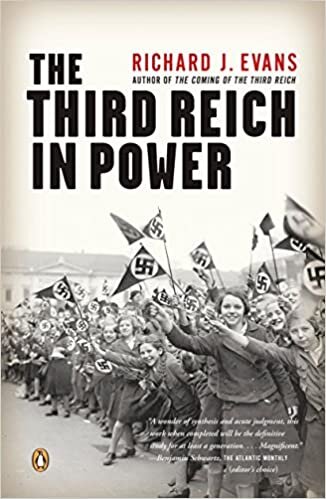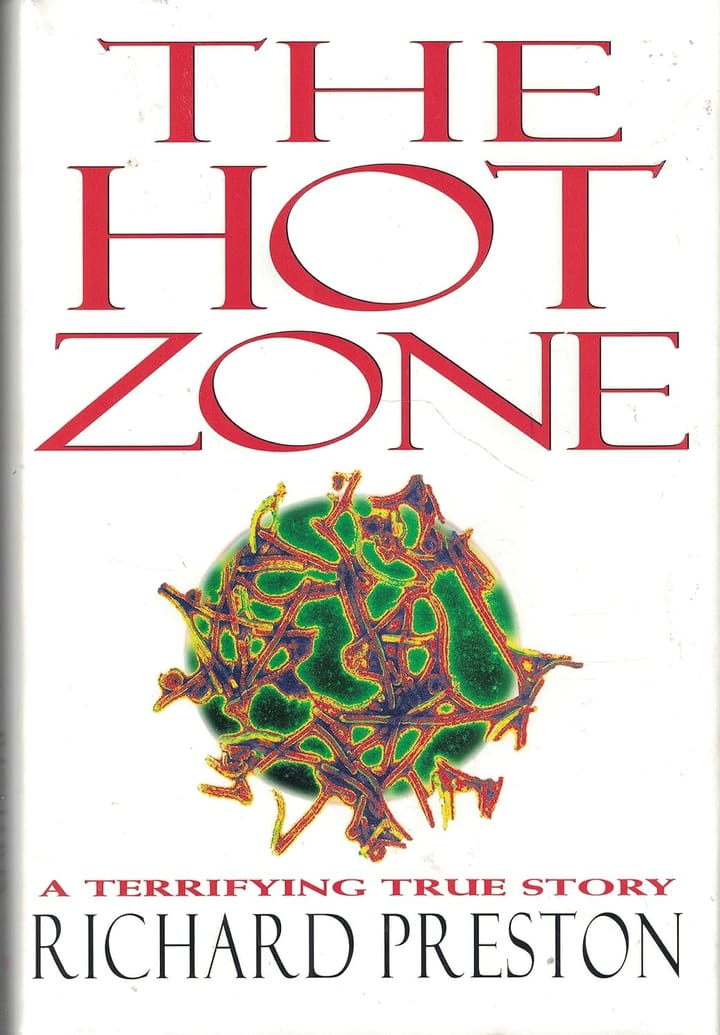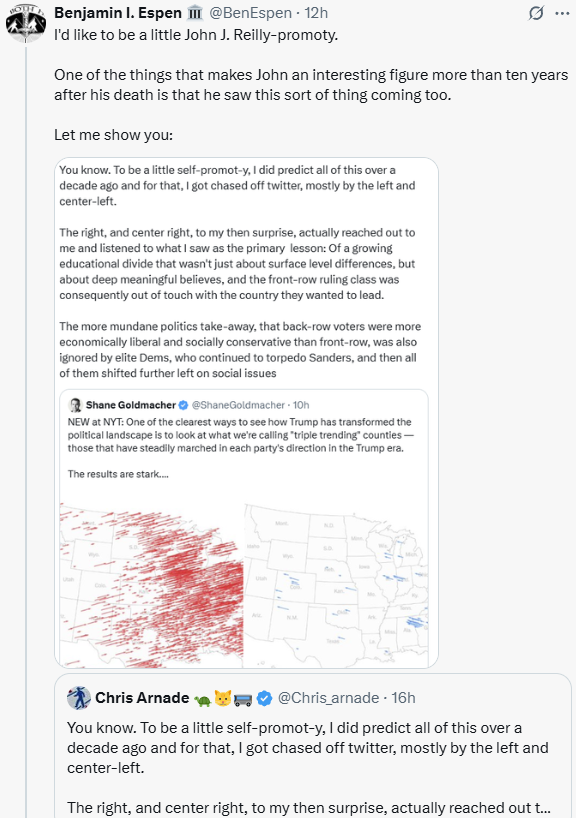The Long View: The Third Reich in Power
Richard J. Evans shows that the Third Reich was about Art and Health.

The Third Reich in Power
By Richard J. Evans
The Penguin Press, 2005
941 Pages, US$37.95
ISBN 1-59420-074-2
A thousand years would be needed, I think, to read all the books that have already been written about the 12-year Reich. A happy, if bulky, addition to this ever-swelling literature is this middle volume of a planned trilogy by Richard Evans of Cambridge University, who has also written extensively on other aspects of German history and on historiography. The first book, The Coming of the Third Reich (2004), dealt with the origins of the Nazi movement and on how it came to power. A further volume will cover its downfall in the Second World War. The Third Reich in Power is essentially a social history of the Third Reich at peace, from 1933 to 1939, but social history of a peculiar sort. Social histories are often designedly indifferent to politics, treating it as an epiphenomenon. That approach is not really possible with the Third Reich, where so much social change was politically driven. Some of the sources are old-standbys; we hear a great deal from William Shirer and Albert Speer, for instance, but also from diarists obscure and famous, from those that supported the regime and those persecuted by it. A valuable semi-official source is the reports from the agents of the Social Democratic underground to their exiled leaders in Czechoslovakia. The result is not quite “everything there is to know about the Third Reich,” but enough to give this volume some hope of becoming the standard popular history of the period.
The book effectively answers some fashionable conjectures of recent decades, particularly the notions that the regime was too polyarchic to be called totalitarian, and even that it stumbled into war more by accident than by design. By no means was the regime wholly successful in these years in transforming Germany in the way it had planned, but it was successful to a large degree, with the prospect of yet greater success if it had survived longer.
In domestic policy, the Nazi regime was chiefly concerned with Art and Health. The characterization of Hitler as an Artist Politician is not new, but it does help clarify the period. Among Hitler’s contemporary totalitarian tyrants, he stands out for the number of statements he made about the arts and for the serious attention he gave to some of them. There was some diversity of opinion in the Nazi movement about the sort of artistic atmosphere the new Reich should foster, but there was no doubt that artistic policy was key to the society the leadership wanted to make. When the Nazi preference was clear, the party and state were quite capable of making it effective. By the middle of the ‘30s, Propaganda Minister Joseph Goebbels directed that “art criticism” be replaced by “art reporting”: by that point, pretty much all the items in the art museums were there because the Nazis wanted them there; therefore, criticism of them would have been implicit criticism of the regime.
The author is at pains to emphasize the the regime’s tastes were essentially modern. In music, for instance, though the Nazi establishment had a strong aversion to atonality, it was quite capable of endorsing Carl Orff’s Carmina Burana, which is recognizably a modernist exercise. The Nazi insistence on the use of neoclassical for state architecture differed only in its larger scale from the preferences of major governments throughout the world at the time. The sleek, aerodynamic styling of the Volkswagen might serve as an icon of 1930s industrial design, and it came from Hitler himself.
Moreover, despite the regime’s general disfavor of Expressionist art, the system as a whole was an exercise in expressionism, in the sense of the manifestation of emotion through an idiom specially created for the purpose. The Nazis did not seek to destroy Germen society, or at least not as much of German society as the Bolsheviks sought to destroy of Russian society. Rather, all of Germany was to be “coordinated” into a single work of art, with each piece of it transformed, virus-like, by the injection of Nazi personnel and worldview. Everywhere the Leader Principle was applied, so that every club, business, and municipality had its own little dictator. Leaders were appointed rather than elected. Councils and assemblies became the leader’s “retinue.” In terms of political science, the effects were surreal. Nazi ideology disfavored federalism, for instance, so the German states were abolished. At any rate, their democratic governments were abolished. The state administrative apparatus was preserved; the expanded national administration was just laid on top. The redundant organs of government became fields of patronage for the party faithful.
It really is true that the administration of Nazi Germany was a pillow fight among competing jurisdictions. However, this was not an anomaly, but essential to the movement. It seems to this reviewer that the Nazis had a very un-German undifference to the Hegelian ideal of the state as the embodiment of reason, an indifference that the early conservative supporters of the regime did not grasp until it was much too late. The legal state interested the Nazis only as an assemblage of useful administrative machinery. The regime’s policies were increasing carried out by what the author calls the “prerogative state,” centered in the Nazi Party, which was not bound by ordinary notions of property, due process, or even such basic principles as the prohibition on ex post facto laws. The result was not efficient, but it was not intended to be. The rigidities of ordinary government were dissolved, the better to melt Nazism into society.
The most curious manifestation of the drive for Health was to be found in the universities. The Right in general and the Nazis in particular were popular on campus during the terminal crisis of the Weimar Republic. During the period covered by this book, however, the number of university students halved. Literature and law ceased to be the most widely studied subjects; the most popular major became medicine, but medicine with a twist. The Nazis needed people with medical qualifications to carry out its policy of racial hygiene, and more generally they needed an educated class that thought in eugenic terms. Such a curriculum necessarily included a large dose of pseudo-science and pure indoctrination (though the author reminds us that it was a Nazi epidemiologist who first recognized the link between cancer and smoking). In any case, the universities were willing to supply the regime’s demand. The liberal arts continued to be studied, but on a smaller scale and in a politically timid fashion. The hard sciences also suffered partial eclipse, despite occasional complaints from various centers of the Nazi state about the decline in the number of truly qualified scientists and engineers.
No matter what students studied or at what age, more and more of their time was taken up in physical training. Soon there was an obligation for a stint of labor on public projects. The Third Reich espoused an ideal of classlessness that it did not always reach, but the Hitler Youth and the Labor Service really did bring middle-class children into contact with the lower classes, often with the result that the latter beat up the former. In any case, the Nazis conceived of a high level of aggressiveness in boys as a mark of the rude good health they were seeking to promote.
One might simply include the persecution of the Jews as an element of the drive for racial purity, were it not for the fact that the Nazis’ peculiar antisemitism was prior in principle to almost everything else they did. The book provides a good refutation of Daniel Goldhagen’s thesis that German culture was infected by an “eliminationist antisemitism” that was simply waiting for an opportunity to express itself. The fact is that the persecution of the Jews was not one of the things that the regime did to make itself popular. Quite the opposite: crude expressions of antisemitism sometimes generated a backlash that caused the Nazis to retreat for a time. Until the outbreak of the war, Nazi policy was to encourage Jewish emigration, to Germany’s neighbors if need be, but preferably outside Europe. Indeed, late in 1933 the Nazi authorities made a deal with the Zionists in Palestine to facilitate the movement of German Jews to that country. The terms of emigration were particularly favorable, allowing the exiles to keep more of their property than exiles to European countries normally could.
The accelerating expropriation of Jewish-owned enterprises was also not in response to popular demand, with the possible exception of the sentiment among small retailers for the takeover of the department stores. In the beginning, non-Jewish buyers of Jewish businesses often tried to offer fair market value (which was not always approved by the Nazi authorities) or to make secret side deals whereby the new owners became trustees against the day when the situation in Germany became normal again. As time when on, though, the German business community understood that the looting was not going to stop, so they got with the program. Similarly, though the anti-Jewish attacks by Party members during the first year of Nazi power had to be suppressed to reassure the populace that the new government believed in law and order, the general assault on German Jewry in November 1938, known as “Kristallnacht,” had some aspects of a popular pogrom. The popular enthusiasm, for the most part, was provided by the Hitler Youth. They had learned more than calisthenics in all those camp meetings.
Meanwhile, the regime cautiously became more anti-Christian. The book deals at length with the Nazis’ early attempt to turn the Evangelical Church into a national church, with a suitably Nazified theology. This effort met with some early success in the German Christian Movement, but the Protestants, for the most part, rejected the project, many turning instead to the Confessing Church. In this account, the Catholic Church appears more systematically willing and able than its Protestant counterparts to defend its institutions from government encroachment, and even occasionally to denounce Nazi racism. However, the church of the martyrs in this story is the Jehovah’s Witnesses rather than the major denominations. Both Catholics and Protestants tended to confine their opposition to the regime’s antisemitic campaigns to the defense of converts from Judaism. Eugenio Pacelli, a Vatican diplomat until March 1939 and then Pope Pius XII, comes off as diligently anti-Nazi but not terribly effective.
None of the churches were very effective. All saw their social and charitable institutions expropriated or co-opted, their publications closed all at once or bit by bit. There were elements in the regime that promoted a return to paganism, though that project found little favor with Hitler. The Nazi leadership was content to apply steady pressure to separate the young from their parents’ confessions; more decisive measures could wait until the successful conclusion of the regime’s larger project.
Art and Health were simply a means to an end, and that end was War. The author argues that the Third Reich makes sense only if we suppose that, from the first day of the regime, the plan was for first a continental war and then a global war. Only once did Hitler try to get this agenda down on paper, and the details he gave in his recorded conversations often varied. Nonetheless, it is clear that he envisaged a European war in the early 1940s that would acquire living space for Germany in Eastern Europe; one to three generations later, there would be a global war against the United States. (He thought that the British Empire would collapse in the meantime.)
This was a fantastic agenda for the leader of a country that was broke, had a skeleton military, and did not even enjoy sovereign rights over all its own territory. Everything had to be done at breakneck speed; it is this necessity that explains the bewildering improvidence of the Third Reich. Nothing about the Nazi system was sustainable, but it was not supposed to be sustained: victory in the first war would so transform the Reich’s situation that all the current deficits would be made good.
The German economy had actually begun an ordinary recovery before the Nazis came to power in early 1933. Hjalmar Schacht, the man who had defeated the Weimar inflation, was given control of the nation’s finances. He aided the expansion with an ingenious but fairly orthodox reflation plan. Within three years it worked. Any other government would then have begun paying attention to balanced budgets again, to making the currency convertible again, and to promoting exports. Instead, the regime promulgated the Four Year Plan, which put an already overheating economy into overdrive through spending on the military and military-related industries. Quickly there were shortages of labor and materials, which the government dealt with through price controls and by binding workers legally to their jobs. Currency controls became stricter, and taxes rose ever higher. (A note to the world’s supply-siders: the German economy almost doubled in size during a period when taxes rose almost continuously.) The Third Reich would run out of stuff and money and people at no distant date, but again, this was not an oversight. The regime intended to restore balance with plunder, including forced labor. If the other powers of Europe failed to take steps in good time to stop this enterprise, one might reasonably suspect that their reluctance was based less on cowardice than on a failure of imagination.
The author points to many instances where the Third Reich’s policies worked at cross purposes. The darling of Nazi ideology was the yeoman farmer, a class that the regime planned to increase and to protect against misfortune. And in fact, conditions did improve for farmers substantially, though not as much as they would have if the government had allowed agricultural prices to rise to meet demand. However, the agricultural authorities had a neo-feudal inspiration: they attempted to “entail” the ownership of middle-sized farms. This meant that the property could not be sold to pay a debt and the oldest son would inherit the whole farm, without dividing it among the other siblings. The policy was supposed to protect farmers against their creditors and to ensure that farms did not get smaller and smaller; the younger sons would be given land in the East, either in Prussia or, later, in Russia. The actual effect, of course, was that entailed farms could not get credit and the younger siblings left the agricultural sector entirely.
The Nazi regime was pronatalist, as indeed were most other governments in Europe at the time. Germany, however, took extraordinary measures. The direct subsidies for large families were more than generous. Official policy made it difficult for women of child-bearing age to attend universities, and professional careers for women were discouraged. There followed a notable increase in fertility, but the author is skeptical about the degree to which this was a result of government action: as with armament production, the increases look large in part because they are measured against the low base of 1933. At the same time, however, the regime was demanding that everyone devote an increasing amount of time to Nazi-sponsored activities in connection with their work, or their neighborhood, or the Hitler Youth. The effect was to promote houses stocked with snarly, brown-shirted children where there was less and less home life.
The most glaring examples of contradiction are economic. On one hand, the regime wanted to prepare for a war of attrition, which required stockpiling raw materials and finding substitutes for whatever might be in short supply. The ideal was autarky, the independence of the economy from the need to import or export. On the other hand, the regime was planning to begin its first military campaigns very soon, so it needed to buy materials abroad as soon as possible. The problem was exacerbated by the fact the Nazi disinterest in exports meant that there was little foreign exchange to pay for the critical military imports.
All in all, life in the Third Reich seems for most people to have been not so much terrifying as exhausting. Average wages never quite matched the best year of the Weimar period. Shortages of goods appeared in peacetime. The demand for overtime work increased and compliance was less and less voluntary. The regime’s demand for praise and communal activity seemed bottomless. So was its demand for money outside the regular taxation system. The great industrialists paid fortunes in protection money to Nazis great and small in order to maintain a dwindling control over the direction of their own enterprises. Ordinary people were accosted on the streets and at work by brown-shirted beggars carrying collection boxes; the neighborhood Nazi Party organizations knocked on the doors of residents to demand money more systematically for Nazi charities and social-welfare organizations. To add insult to injury: though many Germans made substantial installment payments on Hitler’s slick new Volkswagens, not a single one was produced for a consumer in the course of the regime.
This book provides a convincing, balanced account of the first half of the Nazi era. It brings together into an attractive synthesis many primary sources that have become available in recent years. It is extremely accessible, indeed perhaps excessively so: almost all the German terms are englished, even those usually preserved in popular histories. Hitler himself is transformed from the “Führer” to the “Leader.” Still, this is a serious work. We all know how this trilogy turns out, but this reviewer is keen to get hold of the third volume.
Copyright © 2007 by John J. Reilly



Comments ()